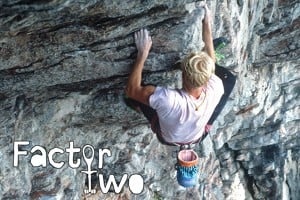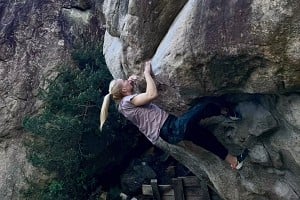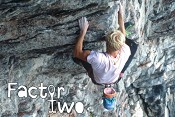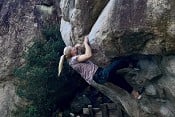
I've been trying to find out if there is any utility in using an adjustable lanyard in crevasse rescue, or a good reason as to why using one could be potentially dangerous. I'm going to Chamonix quite soon and I'm wondering if a lanyard like the Petzl connect adjust could be useful for holding the initial weight of a climber in a crevasse?
The scenario I have in my mind is that my climbing partner falls in a crevasse and I perform an ice axe arrest. From that position, I'm then holding his weight with my body and ice axe. I then successfully dig a trench for the ice axe and bury it with a sling around the middle to form an anchor. Then instead of attaching the anchor to the rope straight away, I first use an adjustable lanyard to attach myself to the anchor first to alleviate the weight. After this I can then continue to attach the anchor to the rope and perform the rest of the crevasse rescue steps. My thoughts on it's usefulness in this scenario is that this will allow me to attach the rope to the anchor using a microtraxion or prussik without having to simultaneously hold the weight of the other climber. This may only be a small advantage but I think it would be worth it. I can't for any reason think of a reason why this could possibly be unsafe.
Is this something that others have experimented with or is there a reason using the lanyard in this way would be unsafe or inefficient? I know some people use daisy chains for a similar purpose but I would think that the ability to adjust the length provides an advantage over daisy chains.
Please let me know your thoughts.
> The scenario I have in my mind is that my climbing partner falls in a crevasse and I perform an ice axe arrest. From that position, I'm then holding his weight with my body and ice axe. I then successfully dig a trench for the ice axe and bury it
How do you simultaneously hold someone on an ice-axe brake and dig a trench and bury the axe!? Once (if) you stop, I think you will be using your legs/body/rope friction to hold the weight.
Doesn't sound unsafe, but it does sound like extra faff. It should only take 30 seconds to take your pulley off your harness, attach it to anchor and then attach to the weighted rope.
Also, you could just use an extra screw gate to attach yourself to the sling coming off your buried axe, this would be quicker than attaching the lanyard.
Would you be intending to keep the lanyard attached to your belay loop the entire time? If 'yes', this is extra clutter on your harness which will be bothersome, if 'no', then you are introducing way more faff than just using a pulley.
Lastly, carrying the lanyard is unnecessary extra weight. You may say, well its only an extra 200g, which is true, but if you think that for this, then you likely think the same for a load of other unnecessary gear and suddenly you are carrying an extra 2kg.
So personally, it would be a no. Fair play for having a good think about ways to improve the system though.
Fair enough, I guess I should say, brake with ice axe, then kick feet in/secure my position, then dig the trench. There are also other possibilities such as, another person digs the trench. The fundamental point I'm trying to make is, is it worth backing up my position as soon as possible with the Lanyard before carrying out the rest of the rescue process?
I guess I don't really see how the lanyard is quicker or less faffy than the pulley or whatever you plan to use in the "final" condition. If you manage to get a solid anchor, aren't you then looking to transfer the load to the rope anyway as the next step? How does the lanyard help?
> The fundamental point I'm trying to make is, is it worth backing up my position as soon as possible with the Lanyard before carrying out the rest of the rescue process?
The fundamental objective is to get the load from your victim off you and onto the anchor. If you've got an anchor, backing yourself up on it is a bit pointless in respect to getting the load off you.
In the scenario that I envisage, I could be lighter than my partner or my partner has fallen downhill from me so holding the position could be difficult. I thought the lanyard could be helpful because it would allow me to have a backup sooner than if I attach the rope straight away to the anchor. I trust myself to know what to do if someone does fall in a crevasse, but I've not had to do this in practice yet. In my experience, tying a prussik to the rope or applying a microtraxion can be difficult when the rope is under tension. My hope is that a lanyard would allowing me more breathing space whilst performing the next step. I'm assuming that attaching the lanyard is going to be easier to do under strain than attaching the rope directly the anchor hence why I'm suggesting this additional step.
I do take the point that this does mean that I will be taking more stuff. A judgement call would have to be made on whether bringing this lanyard just in case is worth it for the additional weight.
Give it a try. Fill a duffle bag with heavy stuff and chuck it out the window.
I'm being at least partially serious, it's worth practicing ropework in a safe environment.
Have you considered attaching your microtraxion to the rope with a suitable prusik loop attached to your belay loop as part of your glacier set-up? Then if you need to transfer the load to the anchor sling it is just a case of attaching it to this prusik loop - and unclipping yourself. This set-up also means should you fall down a crevasse and need to prusik out, you already have a prusik device on the rope.
I assume you mean with the teeth of the microtraxion up?
So that the microtraxion would grip the rope if your partner were to pull on it, as they would do if they fell down a crevasse. The microtraxion would also be set up for you to climb up the rope were you to be in a crevasse. I hope this answers your question.
I was grateful for my petzl adjust when I went in to a crevasse at Easter
quick to set up with a screw whilst I waited for my wife to get sorted with an anchor
https://m.facebook.com/story.php?story_fbid=pfbid02TdHGHmQSzWT3uB9JWtBzkEij...
Perhaps you are confusing this with the popular practice of having a lanyard to attach yourself to an ice screw if you fall into a crevasse.
A lanyard would appear to be an un-nescessary complication if you are on the surface holding a fall. There are better ways to make that more efficient such as pre placed Prussik/ micro traction etc.
Here's a different way to think about it: if using a lanyard made crevasse rescue setups considerably easier and quicker, then every tutorial video, textbook, equipment manufacturer and guide would be telling people to use them. The fact that it's not wide spread suggests that perhaps they aren't that useful.
Are you not concerned that would result in the rope being ripped if your partner does fall? The manual for the microtraxion does specific that you shouldn't fall on the device with a force greater than 4kN. I don't know if you would generate that force with a fall on a glacier but this is surely a concern?
You can use a Purcell prusik in place of your usual prusik. It’s a sort of leash and useful for transferring loads.
> Are you not concerned that would result in the rope being ripped if your partner does fall? The manual for the microtraxion does specific that you shouldn't fall on the device with a force greater than 4kN. I don't know if you would generate that force with a fall on a glacier but this is surely a concern?
That's a good point; however, it is hard to imagine a situation in which you would generate such a substantial force holding a partner falling into a crevasse.
Remember, you will not be tied down so the force it takes to pull you along the surface is the limit to the force you can apply to your fallen partner - and he can apply to you - via the microtraxion. Even with several people holding the fall I can't see this force being anywhere near 4kN. To give you an idea of the size of the forces, it takes roughly 1kN to lift 100kg off the ground. Any extra friction - from the rope cutting into the crevasse lip and any braking knots - will only further reduce the force you will experience.
I might be misunderstanding the setup, but what I'm envisaging is that you've got the weighted rope clove hitched to a screwgate which is attached to your tie in loop (might be incorrect here but I think this is common practice - you take coils, tie them off then clove hitch the live rope so that when weighted it's pulling your harness and not the coils)
You also have a lanyard attached to your belay loop. Once you've got an anchor, you weight the anchor via the lanyard.
You'd then well and truly be part of the system. In order to escape you've got to get the weight off the lanyard so you can unclip it. This would basically mean doing a kind of horizontal squat lift on the snow to pull the live rope with the weight of your partner plus considerable rope drag, attach a prussic/micro traxion, then squat down to ease the weight completely onto the anchor, at which point you can unclip. Again, I'm possibly missing something here but I don't think it sounds feasible unless you've got particularly beefy legs and a small partner.
If you travel with a prussic ready tied to the live rope, then you can just clip that to the anchor as soon as it's good, which would get the weight off you and onto it much more quickly.
>The manual for the microtraxion does specific that you shouldn't fall on the device with a force greater than 4kN.
4 kN is a huge force, only reached in very big lead falls. There is absolutely no possibility of the rope being ripped in a crevasse rescue situation. As many have said: using a lanyard is just causing unnecessary faff; just trust your prusik/microtraxion setup and your ice axe anchor, and get on with the job.
So the lanyards I've been looking at allow for extension whilst under tension. This way, the weight can be transferred to the rope once that's been attached the anchor without having to lift your partners weight.
I do see how tying a prussik on the rope before setting off on the glacier would achieve the same end that I'm trying to with the lanyard. But the disadvantage of this method would require additional steps to add a microtraxion to the rope after attaching the rope with the prussik or not using the microtraxion.
I really don't think that applying the mictraxion to the rope before setting off if a good idea. Even if it's unlikely that a fall would generate a force greater than 4kN, falling on a device with teeth seems like playing with fire.
Obviously do what you feel most comfortable with. However, at a minimum I'd suggest trying this with a partner/victim in a quarry or somewhere under controlled conditions to see how it goes. My experience with these things is that it's incredibly easy to get in an irreversible tangle, so probably simplest is best.
> I really don't think that applying the mictraxion to the rope before setting off if a good idea. Even if it's unlikely that a fall would generate a force greater than 4kN, falling on a device with teeth seems like playing with fire.
Seems like you're looking for a justification to take a lanyard. All the glory to you if you want to carry extra weight but you can do the exact same thing with just a sling and a crab.
Setting up a crevasse rescue with a prussik and microtrax should not be a problem and guides have been using the preplaced microtrax trick for a while. You'd think they know what they're doing.
> In my experience, tying a prussik to the rope or applying a microtraxion can be difficult when the rope is under tension.
Could you expand on this? I think in both cases I find it easier to do when the rope is in tension. In the case of a microtraxion, you can push the device away from you and allow the teeth to engage, and this way you know you have it the right way round.
Unless you have practiced crevasse rescue extensively in all possible scenarios the chances of a successful outcome are virtually nil. It is a very difficult operation. Your best option assuming you have stopped the fall is to scream for help.
By far the best advice is to do everything possible to avoid falling in in the first place.
Totally agree with that. Once spent time on a glacier with a friend and a guide who got us to take several turns each at falling into a crevasse (sitting on the edge and falling in) and also holding the fall and digging an ice axe belay, setting up pulley systems etc, (with safety backup anchors). The biggest take home message was to avoid this at all costs, certainly as a pair on a glacier. It was incredibly difficult and hard, and that was under ‘controlled’ conditions. I now have great respect for the advice on having a much longer length of rope between each other than you commonly see, and with knots if a pair. Three on a rope is not so bad, but the situation of two on a glacier and one falling in really has to be experienced to understand just how difficult it is.
Elsewhere on the site
Alpine Conditions
This Alpine Conditions page gives a summary of what is being climbed at the moment, what is 'in' nick and what the prospects are...








